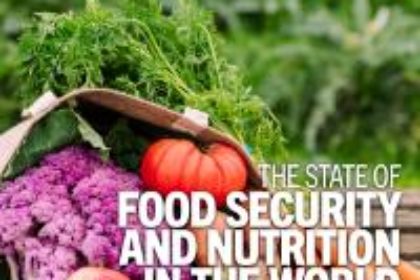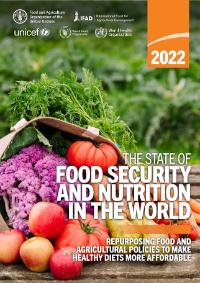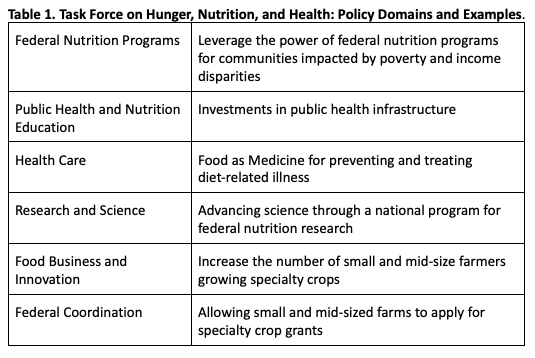
Contributed by Karen Nordstrom, FSNE Policy Network Manager
 Key Messages from the State of Food Security and Nutrition in the World 2022 (the SOFI report) reiterate that rising world hunger and the prevalence of undernourishment have been exacerbated by Covid 19 and have worsened economic inequalities. Inflation and the economic impacts of measures put in place to contain the pandemic have also led to a lack of food affordability across the globe.
Key Messages from the State of Food Security and Nutrition in the World 2022 (the SOFI report) reiterate that rising world hunger and the prevalence of undernourishment have been exacerbated by Covid 19 and have worsened economic inequalities. Inflation and the economic impacts of measures put in place to contain the pandemic have also led to a lack of food affordability across the globe.
With these complications, the SOFI report indicates that food and agriculture policies must be re-examined, particularly those associated with trade and market interventions, as well as fiscal subsidies. Further, it identifies a need for solid institutions to engage and incentivize stakeholders from the public and private sectors, and international organizations to repurpose policy supports to make food less costly and more affordable for those most at risk. Intersectional policies in the environment, health, transportation, and energy sectors will be needed to increase the availability of nutritious foods to consumers, with corresponding food system policies in the social protection and health sectors to protect the most vulnerable, especially women and children.
In response to the SOFI report, FIAN International issued a press release arguing that its annual assessment of progress towards meeting the 2030 zero hunger target of the UN Sustainable Development Goals “paid too little attention to the structural causes of hunger and malnutrition, and the recurrent global food price crisis.” Perpetual power imbalances between industry actors and local communities were not addressed, particularly with regard to repurposing supply chain subsidies, nor does the report “propose profound food systems transformations towards food sovereignty and agroecology.” FIAN pressed for a “genuine transformation” that requires “systemic changes” in the economic systems that perpetuate corporate control over unsustainable food systems.
In America, the recent White House Conference on Hunger, Nutrition, and Health put forth a national strategy to eradicate hunger and nutrition-related health disparities. The strategy involves local and State, Territory, and Tribal governments; Congress and the Federal Government; the public and private sectors; philanthropy; academia; and food supply chain workers. It addresses the following five pillars:
- Improve Food Access and Affordability
- Integrate Nutrition and Health
- Empower All Consumers to Make and Have Access to Healthy Choices
- Support Physical Activity for All
- Enhance Nutrition and Food Security Research
NPR published these Key Takeaways from Biden’s Conference on Hunger and Nutrition in America, noting Biden’s goal to end hunger in America by 2030 through proposed legislation, regulatory changes, and public-private partnerships. This goal includes a push for Congress to permanently extend the child tax credit, raise the minimum wage, expand nutrition assistance programs, initiate front-of-package nutrition labeling, and set in motion healthcare programs to cover medically tailored meals.
Prior to the Conference, the Task Force on Hunger, Nutrition, and Health – a nongovernment, nonpartisan group of subject matter experts and multi-sector leaders – prepared this report that outlined a series of policy recommendations and actions to advance the goals of the conference. These consensus-driven recommendations responded to listening sessions and letters from strategy group organizations, proposing 30 policy recommendations within the following six domains of action (See table 1.). In all, the report comprised “a bold, high-impact agenda for a 21st-century food system that is resilient, equitable, and nutrition-focused.”

During a task force webinar, members advised that this conference should be a starting point to leverage change in the food system. Some of the key levers presented in this visionary approach to programs and politics include: underscoring food as a basic human right; transforming philanthropy; and applying interdisciplinary and participatory research in the fields of agroecology and food sovereignty.
Given the current state of affairs– pandemic-related support is gone and food prices are soaring– Covid has redirected a focus toward food supply chain resiliency. Research by Thilmany et al. (2020) demonstrated that local and regional food systems were “nimble and connected” and “facilitated innovation” through “shorter chains and smaller operations.” In New England, local and regional food systems innovation during Covid 19 occurred in response to market demand and policy changes.
Lessons from Covid 19 have brought greater attention and awareness to local and regional food supply chain resiliency throughout the region. Currently, and well underway, is New England Feeding New England, a research project that will (in part) inform a regional update to the New England Food Vision. The regional policy actions presented in Table 2 showcase the range of food systems adjustments and reforms being undertaken throughout the region.
Table 2. Regional Policy Examples in Relation to Ending Hunger and Improving Nutrition.
| CT | CT increases food assistance for working families |
| ME | Ending Hunger by 2030 and Universal Free School Meals |
| MA | The MA Food System Collaborative submitted this letter to President Biden to inform the White House Conference, and provides Current Legislative Activity |
| NH | USDA Awards 900K to the NH Food Bank for New Hampshire Feeding New Hampshire |
| RI | RI Food Policy Council coordinates the state’s Hunger Elimination Task Force and created a comprehensive database outlining Covid 19 policy responses for food systems resilience and justice |
| VT | A Food Security Plan is underway through Vermont Farm to Plate and Hunger Free Vermont works tirelessly in support of universal free school meals |
To build on these change efforts, and to keep the conference momentum moving, the question that remains is- what needs to be done to steer policy, administration, and governance, along with regional food systems research, in order to transform New England’s food system? For one, we could consider using the John Hopkins Center for a Livable Future Nutrition and Health Food Systems Dashboard. The Dashboard presents 42 policies and actions for healthier diets that are divided into the following categories: agriculture, international trade; research, processing, technology; supply chain infrastructure; financial actions; public institution actions; business incentives; regulations and laws; education and public awareness; and national guidelines. Another valuable resource in this endeavor is Middlebury Professor Molly Anderson’s visionary suggestion that we bring food into the commons in order to support food system resilience while responding to human rights. As these, there are many other initiatives that can deepen and expand our learning. Please contact me to share other resources, events, and/or promising initiatives that you would like to lift up!




